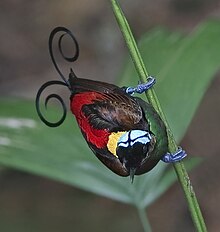Birds-of-paradise
| Bird-of-paradise | |
|---|---|
 |
|
| Wilson's bird-of-paradise (Cicinnurus respublica) | |
| Scientific classification | |
| Kingdom: | Animalia |
| Phylum: | Chordata |
| Class: | Aves |
| Order: | Passeriformes |
| Suborder: | Passeri |
| Family: |
Paradisaeidae Vigors, 1825 |
| Genera | |
|
15 genera, 42 species |
|
15 genera, 42 species
The birds-of-paradise are members of the family Paradisaeidae of the order Passeriformes. The majority of species are found in eastern Indonesia, Papua New Guinea, and eastern Australia. The family has 42 species in 15 genera. The members of this family are perhaps best known for the plumage of the males of the sexually dimorphic species (the majority), in particular the highly elongated and elaborate feathers extending from the beak, wings, tail or head. For the most part they are confined to dense rainforest habitat. The diet of all species is dominated by fruit and to a lesser extent arthropods. The birds-of-paradise have a variety of breeding systems, ranging from monogamy to lek-type polygamy.
A number of species are threatened by hunting and habitat loss.
For many years the birds-of-paradise were treated as being closely related to the bowerbirds. Today while both are treated as being part of the Australasian lineage Corvida, the two are now only thought to be distantly related. The closest evolutionary relatives of the birds-of-paradise are the crow and jay family Corvidae, the monarch flycatchers Monarchidae and the Australian mudnesters Struthideidae.
A 2009 study examining the of all species to examine the relationships within the family and to its nearest relatives estimated that the family emerged 24 million years ago, older than previous estimates. The study identified five clades within the family, and placed the split between the first clade, which contains the monogamous manucodes and paradise-crow, and all the other birds-of-paradise, to be 10 million years ago. The second clade includes the parotias and the King of Saxony bird-of-paradise. The third clade provisionally contains a number of genera, Seleucidis, the Drepanornis sicklebills, Semioptera, Ptiloris and Lophorina, but support values for some of these is inclusions is low. The fourth clade includes the Epimachus sicklebills, Paradigalla and the astrapias. The final clade includes the Cicinnurus and the Paradisaea birds-of-paradise.
...
Wikipedia
